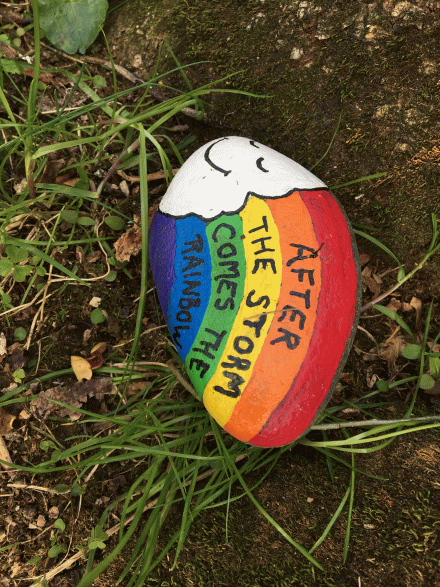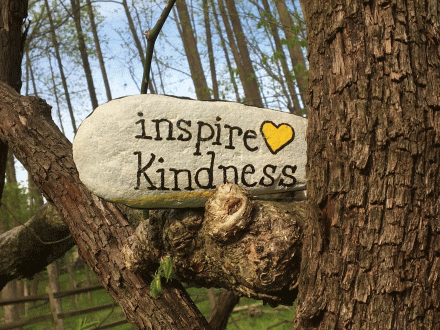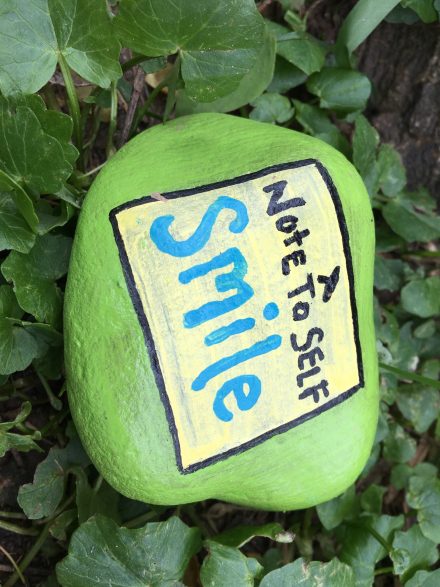
Sermons
You Rock
May 10, 2020
To God’s elect, strangers in the world, scattered throughout…
who have been chosen by God the Father, through the sanctifying work of the Spirit, for obedience to Jesus Christ. Grace and peace be yours in abundance. (1 Peter 1:1-2)
So begins this letter to Christian believers living in troubled times. It’s a letter written for people needing encouragement, a letter of comfort offering clues for living faithfully when feeling alienated and apart.
I need to hear words of comfort and guidance right now. I entered this text with my own personal feelings of frustration and anxiety riding high. Like all of us living through a pandemic, I get stressed when looking too far into the future, when I’m asking questions like: “When will this end?” and “How do I move forward when there’s so much that’s uncertain and unknown?”
One of the events that precipitated my stress was the commencement of discussions on Re-Entry: we’ve got a 20 page document published by the Presbyterian Church, addressing how and when to re-gather as the church community. We’re all wrestling with these questions: What are the guidelines? What are the phases of reopening? Most important: How do we keep one another safe?
We’ve been told to have a process in place but where to even begin? Everything hinges on everything else: safe distancing, number of people who can gather, how to sanitize surfaces. (What do we do with padded pews?) Looking into the nuts and bolts of how we’ll do this: if we are only allowed to have, say, 25 people gather, what do we say to Parishioner 26 who arrives at the sanctuary? How are we going to manage all this? Reservations? Pre-assigned seating? (How does that go over with Presbyterians?)
And how will we do in-person communion? It’s certainly not sanitary to be passing the bread and cups up and down the pews, same with offering plates. How about ordaining new deacons and elders? We have a tradition of laying on of hands for that holy rite. As I told one pastor friend, I’m not reaching out to the computer screen as we ordain folks over Zoom! What about baptisms? If we’re distancing, does that mean I’m not allowed hold the baby over the font? (You may have seen the cartoon where the parent is holding up the baby and while they’re baptized by the minister using a Super Soaker water toy.)
Wrestling with all this, I described it to my Christian Educator Zoom Group, as feeling like a small business entrepreneur starting everything up from scratch…. and feeling like an inordinate amount of energy and creativity was going to be required, and not sensing entirely like I have the skills and insight to do this. Like everyone else, I’m thinking to myself: this is not what I thought I signed up for.
Another of the lectionary texts for this morning was from the gospel of John. Jesus, before his death, has gathered with his disciples and said: Do not let your hearts be troubled. Do not let them be afraid. I go before you to prepare a place for you. And you know where I am going. (John 14:1-7, adapted)
And then Thomas, whom we discussed just several weeks ago, Thomas answered the way I would: But Jesus….. we don’t…. we don’t know where you’re going. We do not know the way.
As I look, then, to this mysterious timeline of how we’ll deal with re-entry as a church, I know that we are all considering going forward as part of families, communities, as citizens. Everything in our lives is affected: schools, childcare, going back to work. As a nation, there are questions to ask about when it’s safe to reopen. We find ourselves asking very difficult questions: Whose lives will we risk? Whose work is essential and how are those workers being cared for and protected?
As I, as we, search for direction, I find the words from this letter writer act as a guide, an inspiration, and a comfort because we’re presented with an image of Jesus as a cornerstone. One of the things I learned in my trip to Jerusalem earlier this year is what a true cornerstone looks like, and how it is used in the overall architecture of a building. A cornerstone is the very first piece set down in construction. (They are the words in Greek in the text: the first stone.) The one I particularly remember is part of the southern/western wall of the Second Temple, the Temple Mount. It’s huge. It’s massive – many times bigger than any other stone that is laid on top. Think of it more as the bottom of the Great Pyramid, rather than those decorative corner pieces that are set in the sides of church buildings, showing the year they were built.
It is a foundational stone. And what it does is set the pattern for everything else that gets built. The direction: East/west/north/south. Every other stone, smaller stone, is laid on top, placed according to that plan.
When we ask: how do we rebuild after COVID-19? The one thing we know for certain is that we will not return to normal. Even Governor Hogan was saying that in recent days. We will not return to normal. The patterns that we’ve lived by are not going to be the patterns of the future. We are – all, like the hearers of that letter to an early church – we are now living as exiles, far from the psychic, economic, social land from which we came. We’re trying to figure out a way to live – and, for this CPC community, – a way to live in faithfulness to God through Christ.
We are not going back to what was normal. So much is gone.
It’s appropriate to lament, to grieve what’s been lost and may never be recovered. It’s appropriate to cry together and to name our sorrow and our pain.
It’s appropriate to remind one another that we must learn to breathe,
to face one day at a time,
to not live so far in the future that worry becomes the lens through which we see it all,
and to encourage one another to look for and receive assistance – particularly mental health assistance and support – as we live through and beyond this wrenching and world-shattering trauma.
We will not return to normal patterns.
We will not be rebuilding on what has always been familiar.
And we need to say this together: maybe that is also a good thing.
This pandemic has exposed the inequality in our systems in harsh and vivid detail.
It has been apocalyptic, as Ken has told us. It has revealed and uncovered both the best and the worst of who we are.
We have been witnesses to so much good. Sacrifice. Compassion. Bravery. For that we are grateful and give thanks to God. Yet, we have seen that despite the truth about how the virus does not discriminate, we have also seen that suffering and risk and remedy are not at all distributed equally. For example, as we figure out this transition to online learning, supervising our family’s education on Google Meet, we’ve seen educational inequality – with poorer children lacking access to online learning because of unavailability of laptops and tablets and Internet connection.
It is not a surprise, but it is apparent that there is not equal access to money – grants or loans – nor access to medical safety equipment. The class lines that divide us have been shown in stark relief.
George Packer from The Atlantic writes:
When tests for the virus were almost impossible to find, the wealthy and connected …. were somehow able to get tested, despite many showing no symptoms. Meanwhile, ordinary people with fevers and chills had to wait in long and possibly infectious lines, only to be turned away because they weren’t actually suffocating. An Internet joke proposed that the only way to find out whether you had the virus was to sneeze in a rich person’s face. (George Packer, “Underlying Conditions”, The Atlantic, June 2020.)
Most tragically, I think, it has become horrifically apparent how decades of inequalities in health care have affected health outcomes. Centuries of racial discrimination have made an impact as people of color are bearing the brunt of infection and death. The Washington Post found last month that black Americans are dying at a disproportionate rate and that majority-black communities in the US have nearly six times the rate of deaths as majority-white communities. Latinos also have been disproportionately hard-hit. (Karla Adam and Miriam Berger, WP, May 8, 2020, Data: Blacks at greater risk of death.)
It was reported that here in Maryland, African Americans account for about 43% of the state’s infections and fatalities despite representing only 30% of Maryland’s overall population. (Nathan Ruiz, New Virus Cases Decline 4 Days in a Row, May 6, 2020, Washington Post)
We need to come to terms with the fact that we do not truly believe that lives matter. We know who is most vulnerable: grocery store workers, populations who must live or work in close proximity – meat-packing plants, those in prisons and detention centers, those in nursing homes and their aids and caregivers, those who harvest food from the fields. We are all being challenged with these realities. We hear these questions being asked: Who gets economic assistance? Who gets aid and safety equipment? Whose deaths are acceptable in order to put the country back to work? We come back to our first questions: When will this end? And how do we move forward?
It was at this point in my writing this message that the session of this church had a Zoom meeting. It happened earlier this week. We were reviewing worship in this new (online) format and there were very favorable comments about the conversational message that Ken and I presented a few weeks back. (I spoke some… he spoke some. We asked each other questions.) And I said to Ken that night: “Hey, I’m stuck on this week’s message. I’ve gotten half way. You are welcome to pick up the other half.” (He declined. Respectfully.) I realized I was stuck because I don’t have THE answer for all of this. I can’t seem to lay out the problem and solve the equation in 15 minutes.
Again, I discovered that our letter-writer gave us a gift. It’s helpful to remind ourselves that they weren’t busy creating Scripture. They were trying to be helpful to people who were struggling in a certain time and place; people who were trying to be faithful in an environment in which they did not have power or authority. But there are words of encouragement here: You’re a royal priesthood! A holy nation. Set apart for service. You are God’s own people… chosen in order that you may proclaim the mighty acts of him who calls you out of darkness into his marvelous light. This you know: the Lord is good. So let yourselves, like living stones, be built into a spiritual house. And the cornerstone, the pattern for your lives, and everything that you are building on has been set for you – the life and ministry of Jesus.
During the first two weeks of Maryland’s stay-at-home order, I, like I’m sure all of you, was feeling inordinately stressed. Because I was filled with such nervous energy, I took a walk along the pathway through the woods near my house. All I wanted was to get outdoors and simply keep from falling apart. As I walked, I noticed a painted stone on a park bench. It was beautifully done. Painted black, with brightly colored dots on it, like Maori art. “Oh, lovely!” I thought.
And as I continued along the path, I saw more stones, painted, with words and images on them. They were placed strategically – in the nook of a tree, on the bottom of the tree trunk, so I could see them as I went along. Peace, one had written on it. A rainbow was on another; there a rock shaped and painted like a frog. A bumblebee. A ladybug. A pac man. A heart with the word Love.
I kept seeing them. And as I got to the place where I turned around and came back towards home, I saw different ones! They were on the other side of the path, again, nestled in the trees, waiting for me to find them.
As I got towards the end of the path, I met a family with young children and I shared with them how delighted I’d been to see those painted rocks and stones. As we talked (from a safe distance) they admitted to being one of the families who had helped to make them. They’d seen one person sharing them and got inspired. What could they do, they’d wondered, despite having limited resources and being cooped up inside, how could they made the community smile? How could they care for their neighbors and bring them joy? Believe me, they did. My spirit was totally revived from their acts of kindness. Small stones, yet they were the means of grace and hope.
We’re not going to have it all figured out. Not for the church. Not for our families. Not for our community, our nation, or the world. But we have something to offer. We are living stones. And we are building on the cornerstone, the one who sets the pattern for what is being built – what we know as the kingdom, the realm of God.
It’s a foundation of love – of caring for our neighbors, particularly the poor, and the vulnerable. It’s a pattern of service – of making sure that people are fed, ensuring that no one should go hungry or without a home. It’s a guide to live with justice – demanding and working for economic and racial equity, for access to quality health care. It’s building on the radical claim that everyone is created in the image of God, and is passionately loved by their Creator, and that no one can be left out from a life of dignity and value and worth.
We are those stones, those living stones, whom the Spirit invites and empowers to be the church. We have voices. Votes. Hands. Hearts.
So: what kind of building is our life – our living stones – now creating in the world? How can we help to build the realm of God?
Liberation theologian Oscar Romero offers this encouragement:
The kingdom is not only beyond our efforts, it is beyond our vision. We accomplish in our lifetime only a tiny fraction of the magnificent enterprise that is God’s work. Nothing we do is complete, which is another way of saying that the kingdom always lies beyond us. We cannot do everything and there is a sense of liberation in saying that. This enables us to do something, and to do it very well. It may be incomplete, but it is a beginning, a step along the way, an opportunity for God’s grace to enter and do the rest. We may never see the end results, but that is the difference between the master builder and the worker. We are workers, not master builders, ministers, not messiahs. We are prophets of a future not our own.
We lay those stones down on top of the foundation of Jesus Christ. May God build, through each of us – through everyone – a church, a world, a future of hope and promise.





